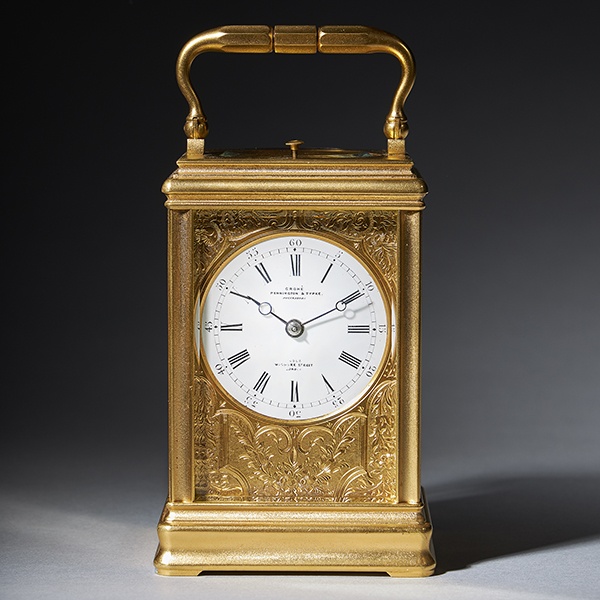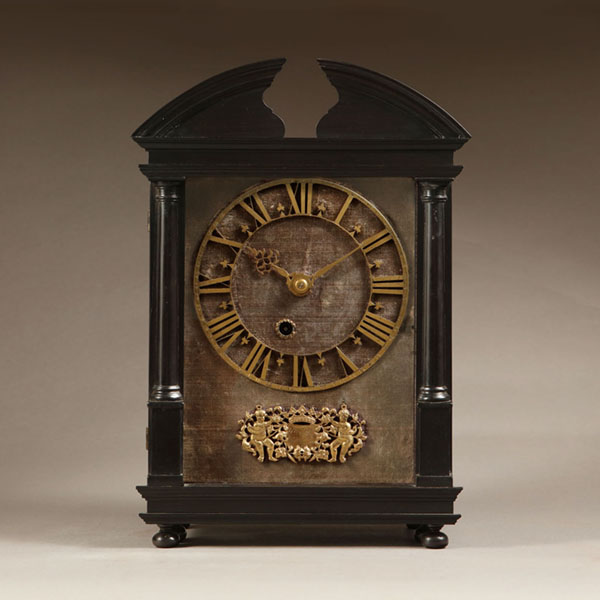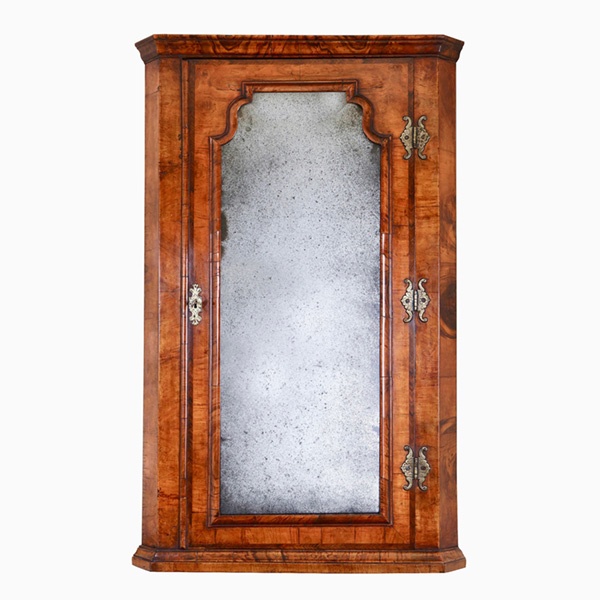Engraved Eight-Day Striking and Repeating Carriage Clock by Perregaux Au Locle
Price Enquiry
Follow Us
Engraved Eight-Day Striking and Repeating Carriage Clock by Perregaux Au Locle
The superb engraved gilt gorge brass case has facetted glass panels to all sides so that the movement is almost entirely visible. The top has a large rectangular window which allows full view of the original silvered platform escapement. At the back, there is a glazed door giving access to the winding and setting arbors, the functions of which are explained indications in French. The clock is surmounted by a typically shaped carrying handle.
The rectangular enamel dial has a Roman chapter ring with an outer minute track with five-minute markers. The time is indicated by a fine pair of blued-steel fleur-de-lys hands. Below is a smaller subsidiary Arabic ring which indicates the alarm time with a blued steel pointer. The maker has marked the dial in the following manner: PERREGAUX AU LOCLE.
The spring-driven eight-day movement of this charming clock is constructed between plates. It consists of going and striking trains, as well as alarm. The going train has an English lever escapement on a silvered platform with hairspring balance and regulation. It can be adjusted by a regulator pin which can be seen through the window in the top and is accessible through the back door. The striking indicates the hour fully and the half hours with a single stroke on a bell. In addition, it has a repeat button at the top, with which the last hour struck can be repeated at will. The backplate is signed by the maker in the following manner PERREGAUX AU LOCLE. The indications near the setting arbors are marked with the words AIGUILLES (‘hands’) and AIGLLE REVEIL (‘alarm hand’), as well as arrows to indicate the direction in which to turn.
Note on the maker
François Perregaux (1834-1877) was born from a family of watchmakers living in the small city of Le Locle in northwestern Switzerland. When he and his two brothers took over their father’s business following his death in 1847, their home region was already well known for watchmaking. However, the organization of the sector was quite different then: the production was scattered, non-industrialized, and thus did not provide merchants with enough financial power to explore the new markets that were essential for their survival. Against all odds, the Perregaux brothers would soon emerge as some of Switzerland’s most international watchmakers. After his early death, the business was taken over by his son Henri (1828-1893). Later the company merged with that of his brother-in-law, the watchmaker, Constant Girard (1825-1903), to form the business Girard- Perregaux. The company still exists today producing high-quality wristwatches.
Condition
Good. Wear consistent with age and use.
Dimensions
Height: 6.5 in. (16.5 cm)
Width: 3.15 in. (8 cm)
Depth: 2.96 in. (7.5 cm)
PREVIOUSLY SOLD
No Results Found
The page you requested could not be found. Try refining your search, or use the navigation above to locate the post.
No Results Found
The page you requested could not be found. Try refining your search, or use the navigation above to locate the post.
YOU MAY ALSO LIKE

19th Century Repeating Gilt-Brass Carriage Clock by the Famous Drocourt
19th Century Repeating Gilt-Brass Carriage Clock by the Famous Drocourt £5,600 Follow Us19th Century Repeating Gilt-Brass Carriage Clock by the Famous Drocourt A superb repeating carriage clock with a gilt-brass gorge case by the famous maker...

17th-Century Hague Clock Signed by Pieter Visbagh, circa 1675
Small 17th Century Hague clock made c. 1675 by Pieter Visbagh, who was apprenticed by Salomon Coster. The latter made the first pendulum clock according to the instructions of Christiaan Huygens, the internationally renowned scientist who developed the idea of applying a pendulum to a clock movement.

Pair of 18th-Century English Rococo Gilt Bronze Andirons or Firedogs
An exceptional pair of 18th century English Rococo gilt bronze andirons or fire dogs.
The bold shape of these andirons relate to designs of Thomas Johnson (1714–1778), one of London’s pioneers of the ‘Modern’ or French style, later known as Rococo.

Oil Painting of a Horse Standing Proud in Woodland
Fine Art – Charles Henry Scwanfelder (1774-1837). Signed C H Schwanfelder Pinx and dated 1825. An exceptional portrait of a horse standing proud in woodland, in front of a tree-lined vista incorporating cows residing by a stream.

Queen Anne Walnut Corner Cupboard with Bevelled Mirror Plate
A truly remarkable find in original condition. To the door a shaped soft bevelled mirror plate is framed by a cross-grain molding of typical queen Anne design which is further cross-banded, feather-banded and edged to the opening with a single de-molding.

19th Century Repeating Gilt-Brass Carriage Clock by the Famous Drocourt
19th Century Repeating Gilt-Brass Carriage Clock by the Famous Drocourt £5,600 Follow Us19th Century Repeating Gilt-Brass Carriage Clock by the Famous Drocourt A superb repeating carriage clock with a gilt-brass gorge case by the famous maker...

17th-Century Hague Clock Signed by Pieter Visbagh, circa 1675
Small 17th Century Hague clock made c. 1675 by Pieter Visbagh, who was apprenticed by Salomon Coster. The latter made the first pendulum clock according to the instructions of Christiaan Huygens, the internationally renowned scientist who developed the idea of applying a pendulum to a clock movement.

Pair of 18th-Century English Rococo Gilt Bronze Andirons or Firedogs
An exceptional pair of 18th century English Rococo gilt bronze andirons or fire dogs.
The bold shape of these andirons relate to designs of Thomas Johnson (1714–1778), one of London’s pioneers of the ‘Modern’ or French style, later known as Rococo.

Oil Painting of a Horse Standing Proud in Woodland
Fine Art – Charles Henry Scwanfelder (1774-1837). Signed C H Schwanfelder Pinx and dated 1825. An exceptional portrait of a horse standing proud in woodland, in front of a tree-lined vista incorporating cows residing by a stream.

Queen Anne Walnut Corner Cupboard with Bevelled Mirror Plate
A truly remarkable find in original condition. To the door a shaped soft bevelled mirror plate is framed by a cross-grain molding of typical queen Anne design which is further cross-banded, feather-banded and edged to the opening with a single de-molding.








